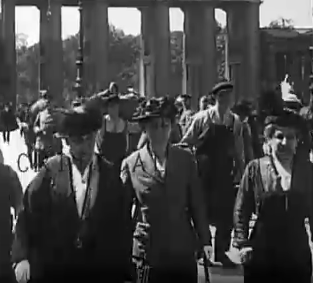
Alice Hamilton was one of those people who used science to shape morality. Basic concepts like sanitation, worker safety, and proper chemical disposal exist because she proved there was no other choice. She was also one of the first to speak out about the growing threat of Nazi Germany.
Technically a biochemist, Hamilton is a science all-star who deserves to be far more famous than she is. She was smart enough to be the first woman to be appointed an assistant professor at Harvard Medical School, and outspoken enough to be nearly thrown out multiple times during her multi-decade career. Once, she put cocaine in her own eyeballs

When she’d worked in Chicago during a typhoid epidemic, she’d shown that flies could carry typhoid between overloaded, filthy communal privies and cramped kitchens without window screens. Her work helped kickstart laws meant to keep landlords from stinting on sanitation or overcrowding their buildings.
Yet Hamilton later found out that her experiment, while correctly done, did not reveal the source of the epidemic. A sewer line had burst and the city had covered it up. Whenever anyone credited her with solving the mystery of the typhoid epidemic—often at the beginning of a speech introducing her—she would immediately correct them. She was the first to speak out against herself.
She was the first to speak out against nearly anything. She helped prove that radium was poisoning watch-painters (so-called “radium girls”). She helped prove that carbon monoxide was poisoning steel workers. She helped prove that mercury was poisoning hatters. She helped prove that excessive use of jackhammers caused “dead fingers” in construction workers. And she helped show that making lead pigment was bad for workers, especially child workers. Most importantly, she spoke publicly and loudly about what she had proved. The most basic worker’s safety concepts were pioneered by Alice Hamilton.

During her college years she’d traveled to Germany with her sister. After World War I, she went back, returning home to rally people to provide food for the starving Germans. Hamilton had been against entry into World War I, considering pro-war stances militaristic and useless. Many Americans were not impressed with the fact that the person who nagged them about staying out of Germany was asking for aid for the people who had been killing American soldiers. Pressure mounted on Harvard to terminate her professorship, which, to their credit, they did not.
Germany recovered. Hamilton went back. And she came back with even more complaints, which also proved to be justified. In 1933, she wrote widely about the rise of the Nazi party, decrying its antisemitism and militarism, and noting the party’s particular appeal to youth culture.

She also wrote about something many social crusaders of her time neglected. Hamilton had worked all her life, in government and in academia, and her German counterparts were getting fired from both spheres. Nazi policy promoted the concept of motherhood above all else. Hamilton pointed out that this wasn’t just sexism, it was a power grab. Every non-Nazi German woman who they kicked out of a position made way for a Nazi sympathizer who could help solidify their hold on public institutions.
Hamilton also was one of the rare academics who managed to study different classes. Having spent her life studying the working class, she wrote about the Nazi policy of sending working class women home—and correctly predicted that it wouldn’t work because, ideals or not, the country needed the labor.
Alas, she didn’t have the clout to stop the Nazis. (How cool a story would this be if she did?) What she did have was connections and drive, and so for most of the 1930s, she provided what help she could to people fleeing Germany.
Hamilton continued being a loud pain in the ass well into the 1960s. She argued that the paranoia about the Cold War was taking away American liberties. She fought against the propping up of anti-Communist regimes. She lobbied for the Civil Rights Amendment. (At first she’d been against it, believing it would take away workplace protections for women.) She was on the FBI watch list into her nineties.
Hamilton died in 1970, age 101, having spent her life being supremely useful to humanity and making pretty much all the right enemies.
Images: (top) “Radium girls” working in a US factory. Public domain. (middle and bottom) Alice Hamilton, young and old. Public domain.